Analysis of Business Resources and Finance in Blue Inc. Operations
VerifiedAdded on 2020/01/07
|16
|4305
|201
Report
AI Summary
This report provides a comprehensive analysis of the business resources of Blue Inc., a retail chain. It begins by describing recruitment documentation for new staff, including a job description and person specification for a finance manager. The report then delves into the employability, personnel, and communication skills essential for a finance manager, highlighting education, work ethic, personal attributes, and communication techniques. It also examines the main physical and technological resources used by Blue Inc., such as land, buildings, IT equipment, and energy, emphasizing their impact on operational efficiency. The report further explores internal and external sources of finance available to Blue Inc., including retained profits, sale of assets, loans, and share capital. It concludes with a focus on managing and controlling budget costs to improve performance, incorporating trading and profit and loss accounts, and calculating contribution and breakeven points. The report utilizes various academic sources to support its findings and recommendations.

BUSINESS
RESOURCES
RESOURCES
Paraphrase This Document
Need a fresh take? Get an instant paraphrase of this document with our AI Paraphraser
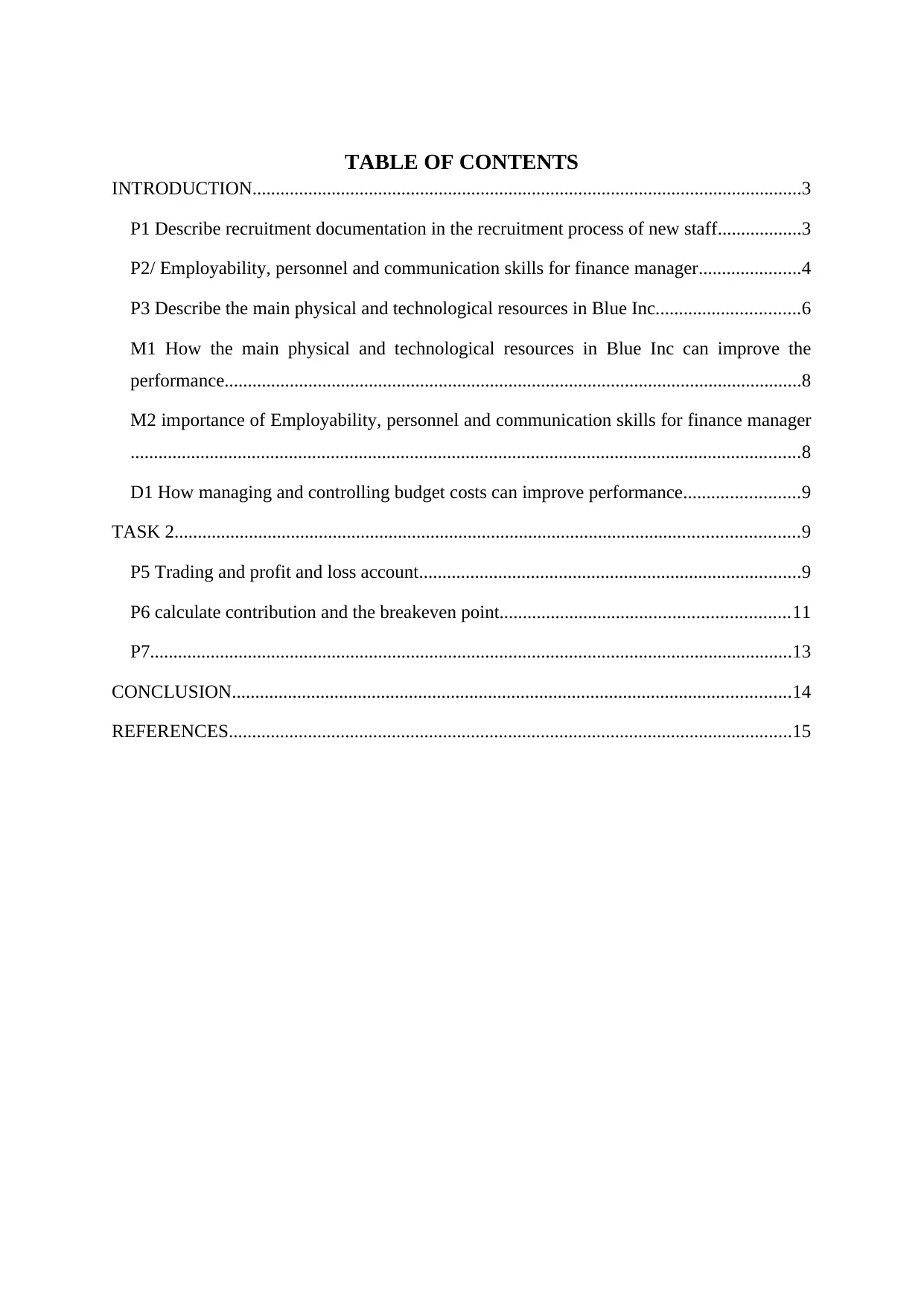
TABLE OF CONTENTS
INTRODUCTION......................................................................................................................3
P1 Describe recruitment documentation in the recruitment process of new staff..................3
P2/ Employability, personnel and communication skills for finance manager......................4
P3 Describe the main physical and technological resources in Blue Inc...............................6
M1 How the main physical and technological resources in Blue Inc can improve the
performance............................................................................................................................8
M2 importance of Employability, personnel and communication skills for finance manager
................................................................................................................................................8
D1 How managing and controlling budget costs can improve performance.........................9
TASK 2......................................................................................................................................9
P5 Trading and profit and loss account..................................................................................9
P6 calculate contribution and the breakeven point..............................................................11
P7..........................................................................................................................................13
CONCLUSION........................................................................................................................14
REFERENCES.........................................................................................................................15
INTRODUCTION......................................................................................................................3
P1 Describe recruitment documentation in the recruitment process of new staff..................3
P2/ Employability, personnel and communication skills for finance manager......................4
P3 Describe the main physical and technological resources in Blue Inc...............................6
M1 How the main physical and technological resources in Blue Inc can improve the
performance............................................................................................................................8
M2 importance of Employability, personnel and communication skills for finance manager
................................................................................................................................................8
D1 How managing and controlling budget costs can improve performance.........................9
TASK 2......................................................................................................................................9
P5 Trading and profit and loss account..................................................................................9
P6 calculate contribution and the breakeven point..............................................................11
P7..........................................................................................................................................13
CONCLUSION........................................................................................................................14
REFERENCES.........................................................................................................................15
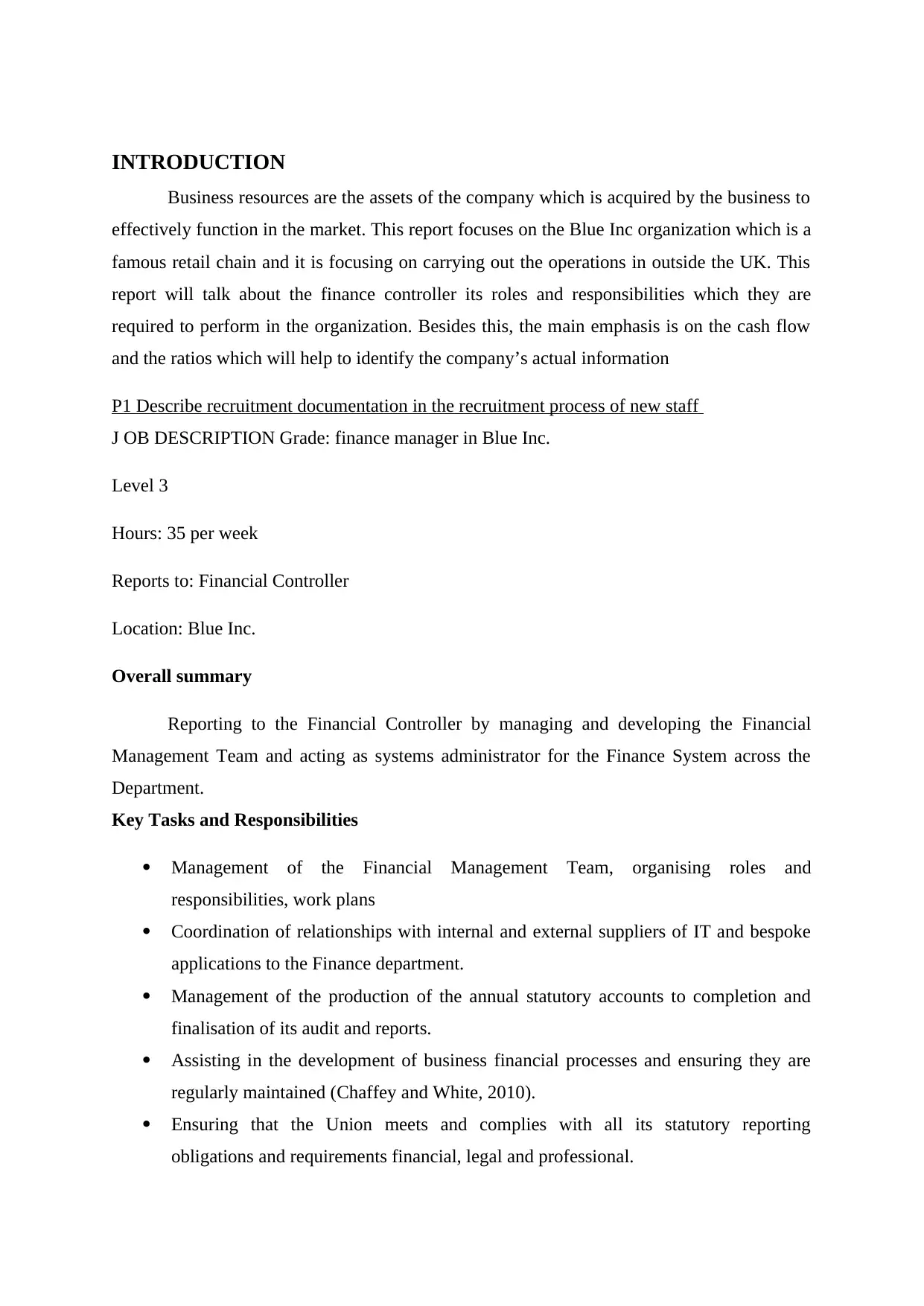
INTRODUCTION
Business resources are the assets of the company which is acquired by the business to
effectively function in the market. This report focuses on the Blue Inc organization which is a
famous retail chain and it is focusing on carrying out the operations in outside the UK. This
report will talk about the finance controller its roles and responsibilities which they are
required to perform in the organization. Besides this, the main emphasis is on the cash flow
and the ratios which will help to identify the company’s actual information
P1 Describe recruitment documentation in the recruitment process of new staff
J OB DESCRIPTION Grade: finance manager in Blue Inc.
Level 3
Hours: 35 per week
Reports to: Financial Controller
Location: Blue Inc.
Overall summary
Reporting to the Financial Controller by managing and developing the Financial
Management Team and acting as systems administrator for the Finance System across the
Department.
Key Tasks and Responsibilities
Management of the Financial Management Team, organising roles and
responsibilities, work plans
Coordination of relationships with internal and external suppliers of IT and bespoke
applications to the Finance department.
Management of the production of the annual statutory accounts to completion and
finalisation of its audit and reports.
Assisting in the development of business financial processes and ensuring they are
regularly maintained (Chaffey and White, 2010).
Ensuring that the Union meets and complies with all its statutory reporting
obligations and requirements financial, legal and professional.
Business resources are the assets of the company which is acquired by the business to
effectively function in the market. This report focuses on the Blue Inc organization which is a
famous retail chain and it is focusing on carrying out the operations in outside the UK. This
report will talk about the finance controller its roles and responsibilities which they are
required to perform in the organization. Besides this, the main emphasis is on the cash flow
and the ratios which will help to identify the company’s actual information
P1 Describe recruitment documentation in the recruitment process of new staff
J OB DESCRIPTION Grade: finance manager in Blue Inc.
Level 3
Hours: 35 per week
Reports to: Financial Controller
Location: Blue Inc.
Overall summary
Reporting to the Financial Controller by managing and developing the Financial
Management Team and acting as systems administrator for the Finance System across the
Department.
Key Tasks and Responsibilities
Management of the Financial Management Team, organising roles and
responsibilities, work plans
Coordination of relationships with internal and external suppliers of IT and bespoke
applications to the Finance department.
Management of the production of the annual statutory accounts to completion and
finalisation of its audit and reports.
Assisting in the development of business financial processes and ensuring they are
regularly maintained (Chaffey and White, 2010).
Ensuring that the Union meets and complies with all its statutory reporting
obligations and requirements financial, legal and professional.
⊘ This is a preview!⊘
Do you want full access?
Subscribe today to unlock all pages.

Trusted by 1+ million students worldwide
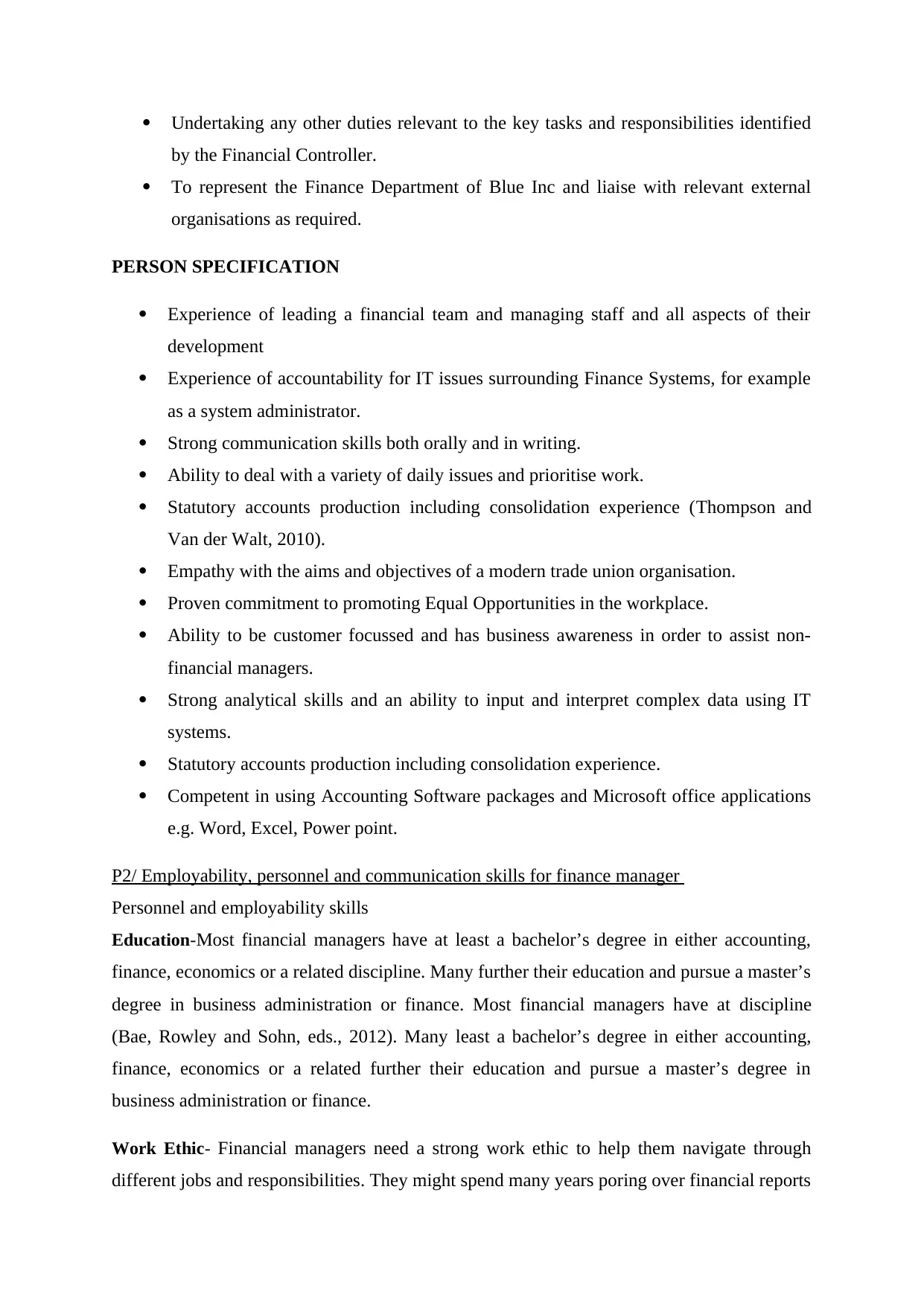
Undertaking any other duties relevant to the key tasks and responsibilities identified
by the Financial Controller.
To represent the Finance Department of Blue Inc and liaise with relevant external
organisations as required.
PERSON SPECIFICATION
Experience of leading a financial team and managing staff and all aspects of their
development
Experience of accountability for IT issues surrounding Finance Systems, for example
as a system administrator.
Strong communication skills both orally and in writing.
Ability to deal with a variety of daily issues and prioritise work.
Statutory accounts production including consolidation experience (Thompson and
Van der Walt, 2010).
Empathy with the aims and objectives of a modern trade union organisation.
Proven commitment to promoting Equal Opportunities in the workplace.
Ability to be customer focussed and has business awareness in order to assist non-
financial managers.
Strong analytical skills and an ability to input and interpret complex data using IT
systems.
Statutory accounts production including consolidation experience.
Competent in using Accounting Software packages and Microsoft office applications
e.g. Word, Excel, Power point.
P2/ Employability, personnel and communication skills for finance manager
Personnel and employability skills
Education-Most financial managers have at least a bachelor’s degree in either accounting,
finance, economics or a related discipline. Many further their education and pursue a master’s
degree in business administration or finance. Most financial managers have at discipline
(Bae, Rowley and Sohn, eds., 2012). Many least a bachelor’s degree in either accounting,
finance, economics or a related further their education and pursue a master’s degree in
business administration or finance.
Work Ethic- Financial managers need a strong work ethic to help them navigate through
different jobs and responsibilities. They might spend many years poring over financial reports
by the Financial Controller.
To represent the Finance Department of Blue Inc and liaise with relevant external
organisations as required.
PERSON SPECIFICATION
Experience of leading a financial team and managing staff and all aspects of their
development
Experience of accountability for IT issues surrounding Finance Systems, for example
as a system administrator.
Strong communication skills both orally and in writing.
Ability to deal with a variety of daily issues and prioritise work.
Statutory accounts production including consolidation experience (Thompson and
Van der Walt, 2010).
Empathy with the aims and objectives of a modern trade union organisation.
Proven commitment to promoting Equal Opportunities in the workplace.
Ability to be customer focussed and has business awareness in order to assist non-
financial managers.
Strong analytical skills and an ability to input and interpret complex data using IT
systems.
Statutory accounts production including consolidation experience.
Competent in using Accounting Software packages and Microsoft office applications
e.g. Word, Excel, Power point.
P2/ Employability, personnel and communication skills for finance manager
Personnel and employability skills
Education-Most financial managers have at least a bachelor’s degree in either accounting,
finance, economics or a related discipline. Many further their education and pursue a master’s
degree in business administration or finance. Most financial managers have at discipline
(Bae, Rowley and Sohn, eds., 2012). Many least a bachelor’s degree in either accounting,
finance, economics or a related further their education and pursue a master’s degree in
business administration or finance.
Work Ethic- Financial managers need a strong work ethic to help them navigate through
different jobs and responsibilities. They might spend many years poring over financial reports
Paraphrase This Document
Need a fresh take? Get an instant paraphrase of this document with our AI Paraphraser
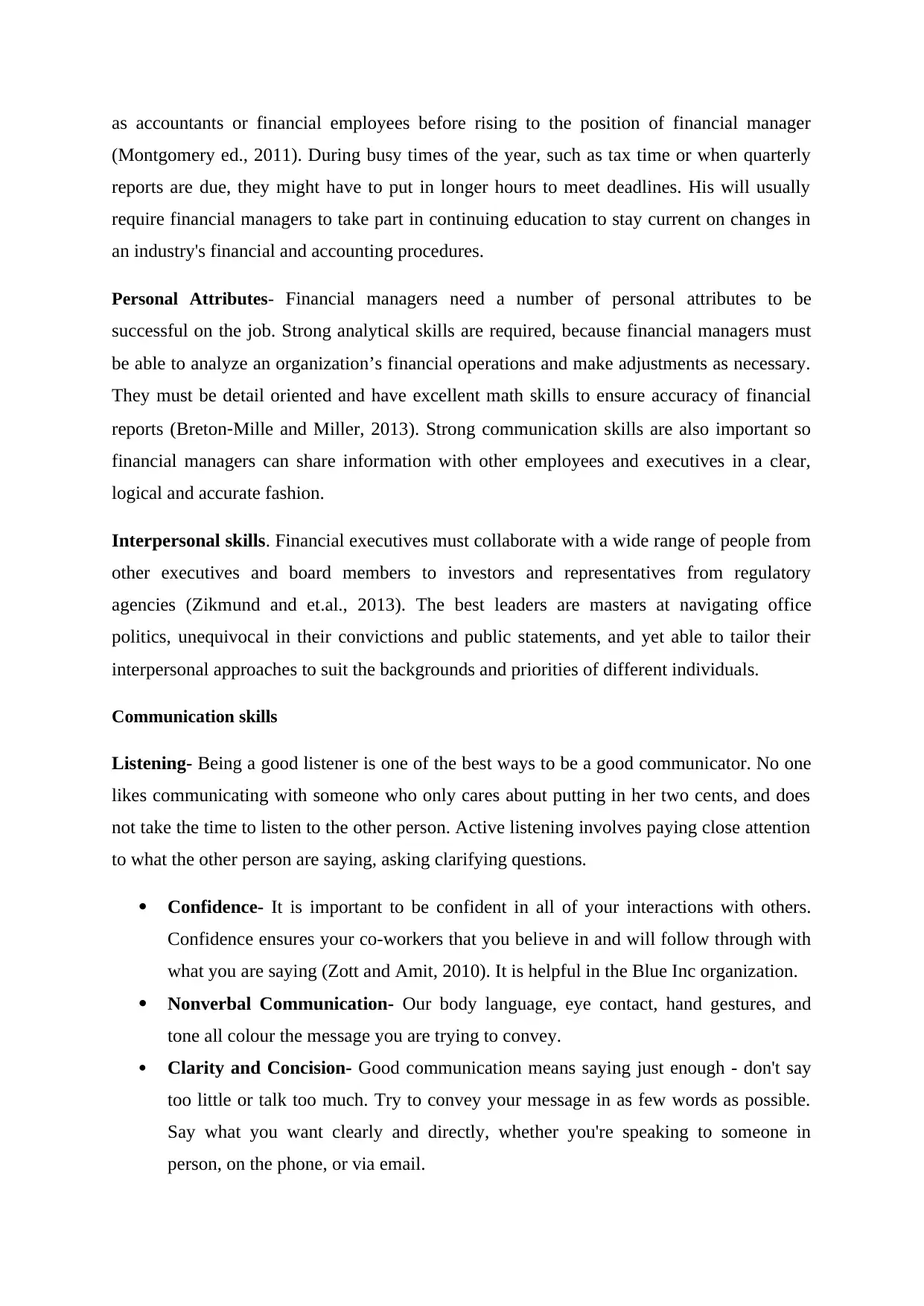
as accountants or financial employees before rising to the position of financial manager
(Montgomery ed., 2011). During busy times of the year, such as tax time or when quarterly
reports are due, they might have to put in longer hours to meet deadlines. His will usually
require financial managers to take part in continuing education to stay current on changes in
an industry's financial and accounting procedures.
Personal Attributes- Financial managers need a number of personal attributes to be
successful on the job. Strong analytical skills are required, because financial managers must
be able to analyze an organization’s financial operations and make adjustments as necessary.
They must be detail oriented and have excellent math skills to ensure accuracy of financial
reports (Breton‐Mille and Miller, 2013). Strong communication skills are also important so
financial managers can share information with other employees and executives in a clear,
logical and accurate fashion.
Interpersonal skills. Financial executives must collaborate with a wide range of people from
other executives and board members to investors and representatives from regulatory
agencies (Zikmund and et.al., 2013). The best leaders are masters at navigating office
politics, unequivocal in their convictions and public statements, and yet able to tailor their
interpersonal approaches to suit the backgrounds and priorities of different individuals.
Communication skills
Listening- Being a good listener is one of the best ways to be a good communicator. No one
likes communicating with someone who only cares about putting in her two cents, and does
not take the time to listen to the other person. Active listening involves paying close attention
to what the other person are saying, asking clarifying questions.
Confidence- It is important to be confident in all of your interactions with others.
Confidence ensures your co-workers that you believe in and will follow through with
what you are saying (Zott and Amit, 2010). It is helpful in the Blue Inc organization.
Nonverbal Communication- Our body language, eye contact, hand gestures, and
tone all colour the message you are trying to convey.
Clarity and Concision- Good communication means saying just enough - don't say
too little or talk too much. Try to convey your message in as few words as possible.
Say what you want clearly and directly, whether you're speaking to someone in
person, on the phone, or via email.
(Montgomery ed., 2011). During busy times of the year, such as tax time or when quarterly
reports are due, they might have to put in longer hours to meet deadlines. His will usually
require financial managers to take part in continuing education to stay current on changes in
an industry's financial and accounting procedures.
Personal Attributes- Financial managers need a number of personal attributes to be
successful on the job. Strong analytical skills are required, because financial managers must
be able to analyze an organization’s financial operations and make adjustments as necessary.
They must be detail oriented and have excellent math skills to ensure accuracy of financial
reports (Breton‐Mille and Miller, 2013). Strong communication skills are also important so
financial managers can share information with other employees and executives in a clear,
logical and accurate fashion.
Interpersonal skills. Financial executives must collaborate with a wide range of people from
other executives and board members to investors and representatives from regulatory
agencies (Zikmund and et.al., 2013). The best leaders are masters at navigating office
politics, unequivocal in their convictions and public statements, and yet able to tailor their
interpersonal approaches to suit the backgrounds and priorities of different individuals.
Communication skills
Listening- Being a good listener is one of the best ways to be a good communicator. No one
likes communicating with someone who only cares about putting in her two cents, and does
not take the time to listen to the other person. Active listening involves paying close attention
to what the other person are saying, asking clarifying questions.
Confidence- It is important to be confident in all of your interactions with others.
Confidence ensures your co-workers that you believe in and will follow through with
what you are saying (Zott and Amit, 2010). It is helpful in the Blue Inc organization.
Nonverbal Communication- Our body language, eye contact, hand gestures, and
tone all colour the message you are trying to convey.
Clarity and Concision- Good communication means saying just enough - don't say
too little or talk too much. Try to convey your message in as few words as possible.
Say what you want clearly and directly, whether you're speaking to someone in
person, on the phone, or via email.
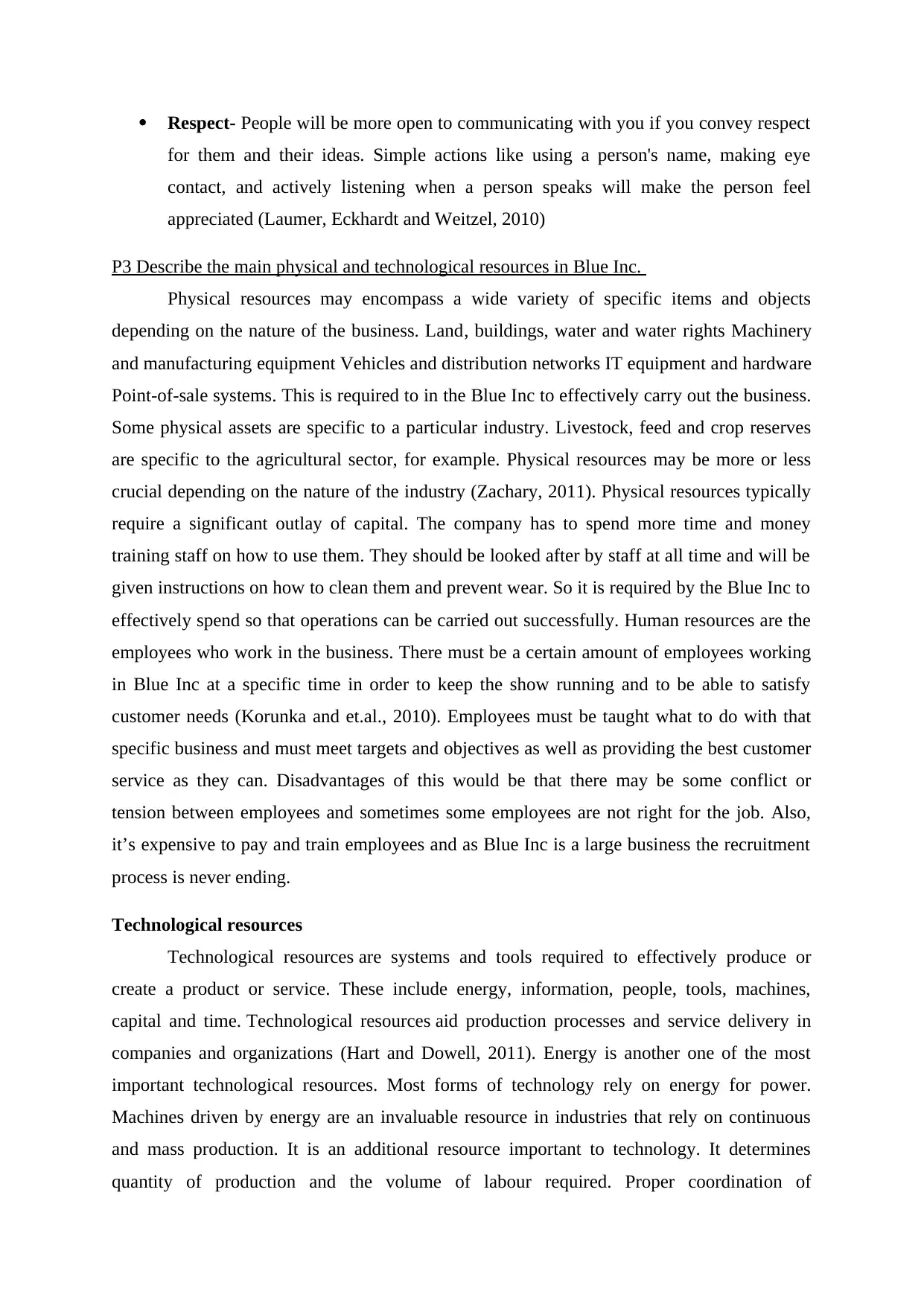
Respect- People will be more open to communicating with you if you convey respect
for them and their ideas. Simple actions like using a person's name, making eye
contact, and actively listening when a person speaks will make the person feel
appreciated (Laumer, Eckhardt and Weitzel, 2010)
P3 Describe the main physical and technological resources in Blue Inc.
Physical resources may encompass a wide variety of specific items and objects
depending on the nature of the business. Land, buildings, water and water rights Machinery
and manufacturing equipment Vehicles and distribution networks IT equipment and hardware
Point-of-sale systems. This is required to in the Blue Inc to effectively carry out the business.
Some physical assets are specific to a particular industry. Livestock, feed and crop reserves
are specific to the agricultural sector, for example. Physical resources may be more or less
crucial depending on the nature of the industry (Zachary, 2011). Physical resources typically
require a significant outlay of capital. The company has to spend more time and money
training staff on how to use them. They should be looked after by staff at all time and will be
given instructions on how to clean them and prevent wear. So it is required by the Blue Inc to
effectively spend so that operations can be carried out successfully. Human resources are the
employees who work in the business. There must be a certain amount of employees working
in Blue Inc at a specific time in order to keep the show running and to be able to satisfy
customer needs (Korunka and et.al., 2010). Employees must be taught what to do with that
specific business and must meet targets and objectives as well as providing the best customer
service as they can. Disadvantages of this would be that there may be some conflict or
tension between employees and sometimes some employees are not right for the job. Also,
it’s expensive to pay and train employees and as Blue Inc is a large business the recruitment
process is never ending.
Technological resources
Technological resources are systems and tools required to effectively produce or
create a product or service. These include energy, information, people, tools, machines,
capital and time. Technological resources aid production processes and service delivery in
companies and organizations (Hart and Dowell, 2011). Energy is another one of the most
important technological resources. Most forms of technology rely on energy for power.
Machines driven by energy are an invaluable resource in industries that rely on continuous
and mass production. It is an additional resource important to technology. It determines
quantity of production and the volume of labour required. Proper coordination of
for them and their ideas. Simple actions like using a person's name, making eye
contact, and actively listening when a person speaks will make the person feel
appreciated (Laumer, Eckhardt and Weitzel, 2010)
P3 Describe the main physical and technological resources in Blue Inc.
Physical resources may encompass a wide variety of specific items and objects
depending on the nature of the business. Land, buildings, water and water rights Machinery
and manufacturing equipment Vehicles and distribution networks IT equipment and hardware
Point-of-sale systems. This is required to in the Blue Inc to effectively carry out the business.
Some physical assets are specific to a particular industry. Livestock, feed and crop reserves
are specific to the agricultural sector, for example. Physical resources may be more or less
crucial depending on the nature of the industry (Zachary, 2011). Physical resources typically
require a significant outlay of capital. The company has to spend more time and money
training staff on how to use them. They should be looked after by staff at all time and will be
given instructions on how to clean them and prevent wear. So it is required by the Blue Inc to
effectively spend so that operations can be carried out successfully. Human resources are the
employees who work in the business. There must be a certain amount of employees working
in Blue Inc at a specific time in order to keep the show running and to be able to satisfy
customer needs (Korunka and et.al., 2010). Employees must be taught what to do with that
specific business and must meet targets and objectives as well as providing the best customer
service as they can. Disadvantages of this would be that there may be some conflict or
tension between employees and sometimes some employees are not right for the job. Also,
it’s expensive to pay and train employees and as Blue Inc is a large business the recruitment
process is never ending.
Technological resources
Technological resources are systems and tools required to effectively produce or
create a product or service. These include energy, information, people, tools, machines,
capital and time. Technological resources aid production processes and service delivery in
companies and organizations (Hart and Dowell, 2011). Energy is another one of the most
important technological resources. Most forms of technology rely on energy for power.
Machines driven by energy are an invaluable resource in industries that rely on continuous
and mass production. It is an additional resource important to technology. It determines
quantity of production and the volume of labour required. Proper coordination of
⊘ This is a preview!⊘
Do you want full access?
Subscribe today to unlock all pages.

Trusted by 1+ million students worldwide
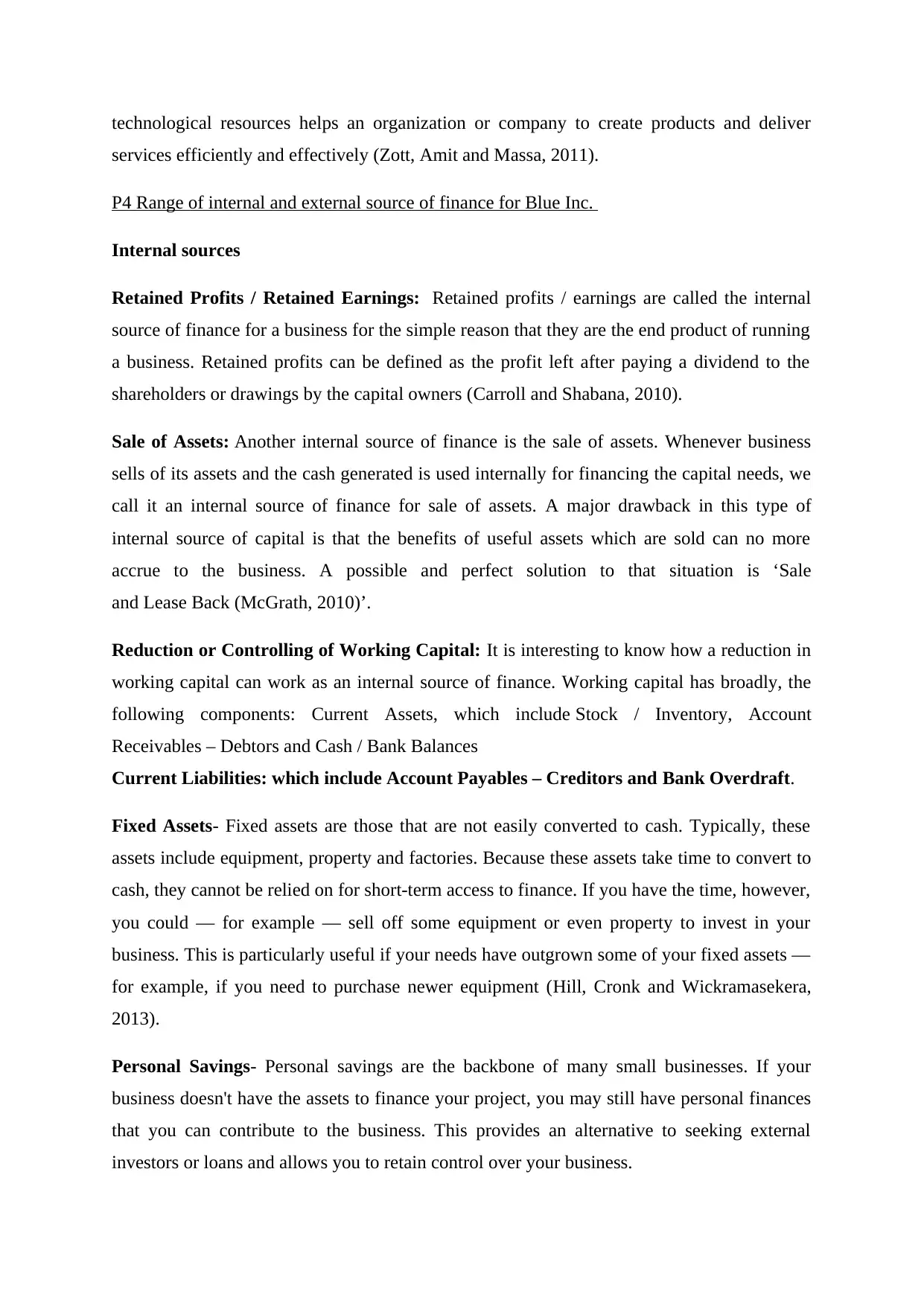
technological resources helps an organization or company to create products and deliver
services efficiently and effectively (Zott, Amit and Massa, 2011).
P4 Range of internal and external source of finance for Blue Inc.
Internal sources
Retained Profits / Retained Earnings: Retained profits / earnings are called the internal
source of finance for a business for the simple reason that they are the end product of running
a business. Retained profits can be defined as the profit left after paying a dividend to the
shareholders or drawings by the capital owners (Carroll and Shabana, 2010).
Sale of Assets: Another internal source of finance is the sale of assets. Whenever business
sells of its assets and the cash generated is used internally for financing the capital needs, we
call it an internal source of finance for sale of assets. A major drawback in this type of
internal source of capital is that the benefits of useful assets which are sold can no more
accrue to the business. A possible and perfect solution to that situation is ‘Sale
and Lease Back (McGrath, 2010)’.
Reduction or Controlling of Working Capital: It is interesting to know how a reduction in
working capital can work as an internal source of finance. Working capital has broadly, the
following components: Current Assets, which include Stock / Inventory, Account
Receivables – Debtors and Cash / Bank Balances
Current Liabilities: which include Account Payables – Creditors and Bank Overdraft.
Fixed Assets- Fixed assets are those that are not easily converted to cash. Typically, these
assets include equipment, property and factories. Because these assets take time to convert to
cash, they cannot be relied on for short-term access to finance. If you have the time, however,
you could — for example — sell off some equipment or even property to invest in your
business. This is particularly useful if your needs have outgrown some of your fixed assets —
for example, if you need to purchase newer equipment (Hill, Cronk and Wickramasekera,
2013).
Personal Savings- Personal savings are the backbone of many small businesses. If your
business doesn't have the assets to finance your project, you may still have personal finances
that you can contribute to the business. This provides an alternative to seeking external
investors or loans and allows you to retain control over your business.
services efficiently and effectively (Zott, Amit and Massa, 2011).
P4 Range of internal and external source of finance for Blue Inc.
Internal sources
Retained Profits / Retained Earnings: Retained profits / earnings are called the internal
source of finance for a business for the simple reason that they are the end product of running
a business. Retained profits can be defined as the profit left after paying a dividend to the
shareholders or drawings by the capital owners (Carroll and Shabana, 2010).
Sale of Assets: Another internal source of finance is the sale of assets. Whenever business
sells of its assets and the cash generated is used internally for financing the capital needs, we
call it an internal source of finance for sale of assets. A major drawback in this type of
internal source of capital is that the benefits of useful assets which are sold can no more
accrue to the business. A possible and perfect solution to that situation is ‘Sale
and Lease Back (McGrath, 2010)’.
Reduction or Controlling of Working Capital: It is interesting to know how a reduction in
working capital can work as an internal source of finance. Working capital has broadly, the
following components: Current Assets, which include Stock / Inventory, Account
Receivables – Debtors and Cash / Bank Balances
Current Liabilities: which include Account Payables – Creditors and Bank Overdraft.
Fixed Assets- Fixed assets are those that are not easily converted to cash. Typically, these
assets include equipment, property and factories. Because these assets take time to convert to
cash, they cannot be relied on for short-term access to finance. If you have the time, however,
you could — for example — sell off some equipment or even property to invest in your
business. This is particularly useful if your needs have outgrown some of your fixed assets —
for example, if you need to purchase newer equipment (Hill, Cronk and Wickramasekera,
2013).
Personal Savings- Personal savings are the backbone of many small businesses. If your
business doesn't have the assets to finance your project, you may still have personal finances
that you can contribute to the business. This provides an alternative to seeking external
investors or loans and allows you to retain control over your business.
Paraphrase This Document
Need a fresh take? Get an instant paraphrase of this document with our AI Paraphraser
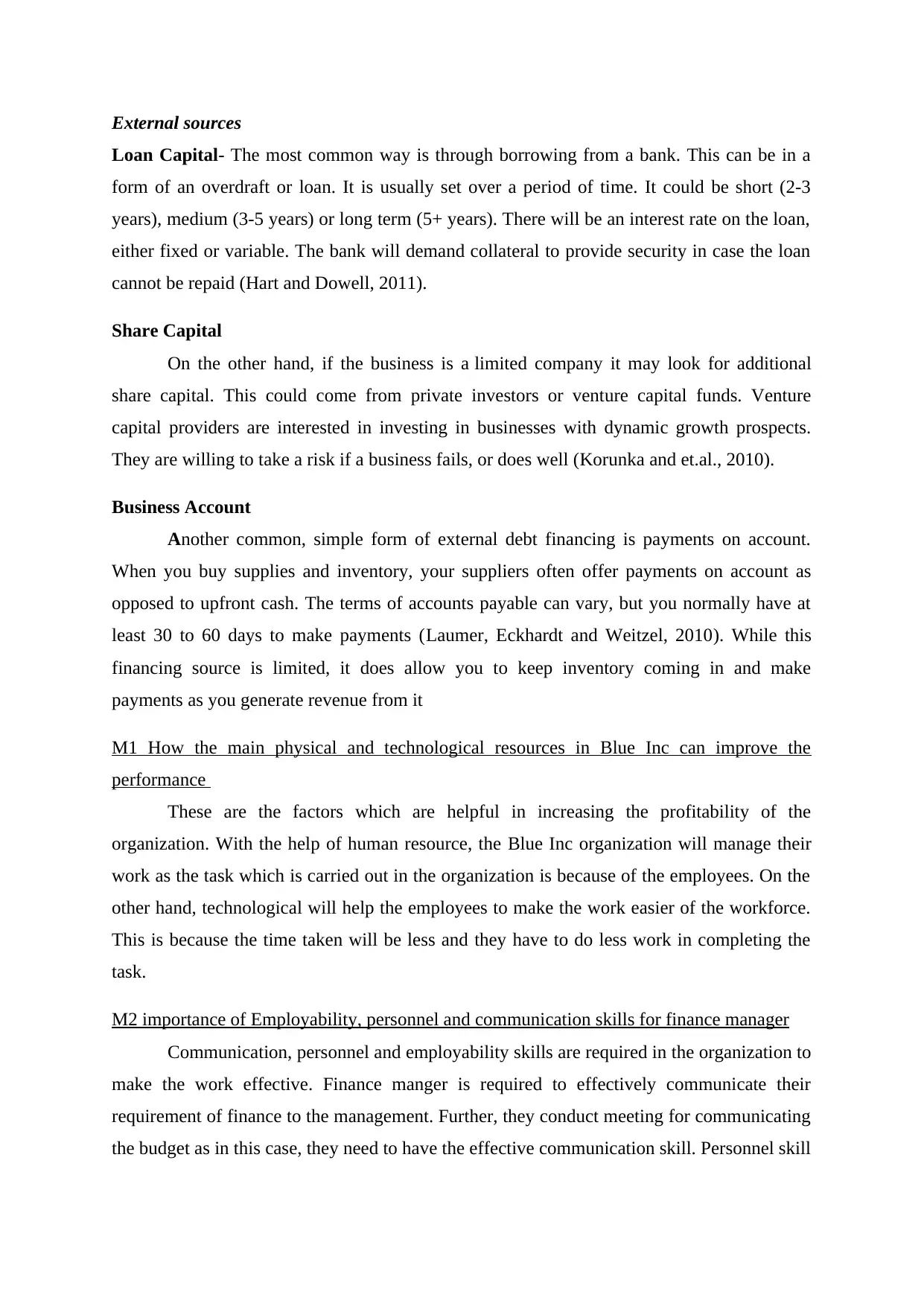
External sources
Loan Capital- The most common way is through borrowing from a bank. This can be in a
form of an overdraft or loan. It is usually set over a period of time. It could be short (2-3
years), medium (3-5 years) or long term (5+ years). There will be an interest rate on the loan,
either fixed or variable. The bank will demand collateral to provide security in case the loan
cannot be repaid (Hart and Dowell, 2011).
Share Capital
On the other hand, if the business is a limited company it may look for additional
share capital. This could come from private investors or venture capital funds. Venture
capital providers are interested in investing in businesses with dynamic growth prospects.
They are willing to take a risk if a business fails, or does well (Korunka and et.al., 2010).
Business Account
Another common, simple form of external debt financing is payments on account.
When you buy supplies and inventory, your suppliers often offer payments on account as
opposed to upfront cash. The terms of accounts payable can vary, but you normally have at
least 30 to 60 days to make payments (Laumer, Eckhardt and Weitzel, 2010). While this
financing source is limited, it does allow you to keep inventory coming in and make
payments as you generate revenue from it
M1 How the main physical and technological resources in Blue Inc can improve the
performance
These are the factors which are helpful in increasing the profitability of the
organization. With the help of human resource, the Blue Inc organization will manage their
work as the task which is carried out in the organization is because of the employees. On the
other hand, technological will help the employees to make the work easier of the workforce.
This is because the time taken will be less and they have to do less work in completing the
task.
M2 importance of Employability, personnel and communication skills for finance manager
Communication, personnel and employability skills are required in the organization to
make the work effective. Finance manger is required to effectively communicate their
requirement of finance to the management. Further, they conduct meeting for communicating
the budget as in this case, they need to have the effective communication skill. Personnel skill
Loan Capital- The most common way is through borrowing from a bank. This can be in a
form of an overdraft or loan. It is usually set over a period of time. It could be short (2-3
years), medium (3-5 years) or long term (5+ years). There will be an interest rate on the loan,
either fixed or variable. The bank will demand collateral to provide security in case the loan
cannot be repaid (Hart and Dowell, 2011).
Share Capital
On the other hand, if the business is a limited company it may look for additional
share capital. This could come from private investors or venture capital funds. Venture
capital providers are interested in investing in businesses with dynamic growth prospects.
They are willing to take a risk if a business fails, or does well (Korunka and et.al., 2010).
Business Account
Another common, simple form of external debt financing is payments on account.
When you buy supplies and inventory, your suppliers often offer payments on account as
opposed to upfront cash. The terms of accounts payable can vary, but you normally have at
least 30 to 60 days to make payments (Laumer, Eckhardt and Weitzel, 2010). While this
financing source is limited, it does allow you to keep inventory coming in and make
payments as you generate revenue from it
M1 How the main physical and technological resources in Blue Inc can improve the
performance
These are the factors which are helpful in increasing the profitability of the
organization. With the help of human resource, the Blue Inc organization will manage their
work as the task which is carried out in the organization is because of the employees. On the
other hand, technological will help the employees to make the work easier of the workforce.
This is because the time taken will be less and they have to do less work in completing the
task.
M2 importance of Employability, personnel and communication skills for finance manager
Communication, personnel and employability skills are required in the organization to
make the work effective. Finance manger is required to effectively communicate their
requirement of finance to the management. Further, they conduct meeting for communicating
the budget as in this case, they need to have the effective communication skill. Personnel skill

assists the manager in developing relationship in the organization. This will help in
improving the bonding among the workers.
D1 How managing and controlling budget costs can improve performance
Managing resources and controlling budget costs can improve the business
performance in many ways. All businesses need to control their budgets but especially large
businesses. Budgets must be controlled in order for a business to make a profit rather than a
loss within their business. They must use their past history in order to predict how well they
will be able to perform in the next month as they can be inspirational for example aim to
increase sales by 2% each month. You must make sure you look ahead for example if you
know some of your part time staff will be leaving you need to make sure you leave a slice of
money in your budget to cover costs for recruitment for example there may need to be more
advertising in order to find the right person. Money would be being wasted and could be
spent on more productive things such as advertising in order to promote the business.
TASK 2
P5 Trading and profit and loss account
Ratio analysis is used to evaluate various aspects of a company's operating and
financial performance such as its efficiency, liquidity, profitability and solvency. The trend of
these ratios over time is studied to check whether they are improving or deteriorating. Ratio
Analysis as a tool possesses several important features. The data, which are provided by
financial statements, are readily available. The computation of ratios facilitates the
comparison of firms which differ in size. Ratios can be used to compare a firm's financial
performance with industry averages
Ratio analysis of Blue Inc is as follows:
Particulars
Figures
(in £)
Profitability ratios
Gross profit (GP) 49431
Net profit (NP) 7897
Net sales 87912
GP ratio Gross profit / net sales * 100 56%
NP ratio Net profit / net sales * 100 9%
improving the bonding among the workers.
D1 How managing and controlling budget costs can improve performance
Managing resources and controlling budget costs can improve the business
performance in many ways. All businesses need to control their budgets but especially large
businesses. Budgets must be controlled in order for a business to make a profit rather than a
loss within their business. They must use their past history in order to predict how well they
will be able to perform in the next month as they can be inspirational for example aim to
increase sales by 2% each month. You must make sure you look ahead for example if you
know some of your part time staff will be leaving you need to make sure you leave a slice of
money in your budget to cover costs for recruitment for example there may need to be more
advertising in order to find the right person. Money would be being wasted and could be
spent on more productive things such as advertising in order to promote the business.
TASK 2
P5 Trading and profit and loss account
Ratio analysis is used to evaluate various aspects of a company's operating and
financial performance such as its efficiency, liquidity, profitability and solvency. The trend of
these ratios over time is studied to check whether they are improving or deteriorating. Ratio
Analysis as a tool possesses several important features. The data, which are provided by
financial statements, are readily available. The computation of ratios facilitates the
comparison of firms which differ in size. Ratios can be used to compare a firm's financial
performance with industry averages
Ratio analysis of Blue Inc is as follows:
Particulars
Figures
(in £)
Profitability ratios
Gross profit (GP) 49431
Net profit (NP) 7897
Net sales 87912
GP ratio Gross profit / net sales * 100 56%
NP ratio Net profit / net sales * 100 9%
⊘ This is a preview!⊘
Do you want full access?
Subscribe today to unlock all pages.

Trusted by 1+ million students worldwide
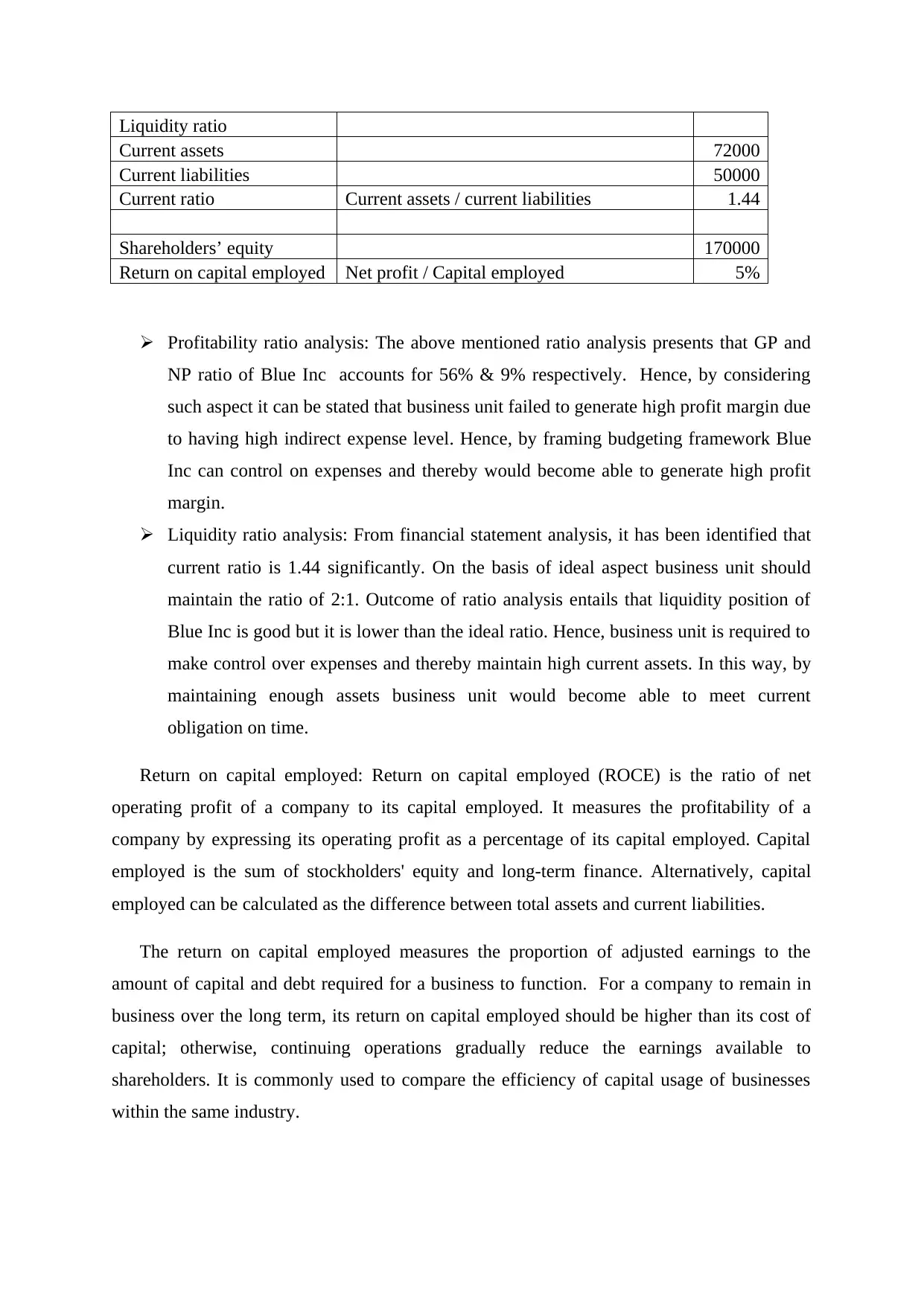
Liquidity ratio
Current assets 72000
Current liabilities 50000
Current ratio Current assets / current liabilities 1.44
Shareholders’ equity 170000
Return on capital employed Net profit / Capital employed 5%
Profitability ratio analysis: The above mentioned ratio analysis presents that GP and
NP ratio of Blue Inc accounts for 56% & 9% respectively. Hence, by considering
such aspect it can be stated that business unit failed to generate high profit margin due
to having high indirect expense level. Hence, by framing budgeting framework Blue
Inc can control on expenses and thereby would become able to generate high profit
margin.
Liquidity ratio analysis: From financial statement analysis, it has been identified that
current ratio is 1.44 significantly. On the basis of ideal aspect business unit should
maintain the ratio of 2:1. Outcome of ratio analysis entails that liquidity position of
Blue Inc is good but it is lower than the ideal ratio. Hence, business unit is required to
make control over expenses and thereby maintain high current assets. In this way, by
maintaining enough assets business unit would become able to meet current
obligation on time.
Return on capital employed: Return on capital employed (ROCE) is the ratio of net
operating profit of a company to its capital employed. It measures the profitability of a
company by expressing its operating profit as a percentage of its capital employed. Capital
employed is the sum of stockholders' equity and long-term finance. Alternatively, capital
employed can be calculated as the difference between total assets and current liabilities.
The return on capital employed measures the proportion of adjusted earnings to the
amount of capital and debt required for a business to function. For a company to remain in
business over the long term, its return on capital employed should be higher than its cost of
capital; otherwise, continuing operations gradually reduce the earnings available to
shareholders. It is commonly used to compare the efficiency of capital usage of businesses
within the same industry.
Current assets 72000
Current liabilities 50000
Current ratio Current assets / current liabilities 1.44
Shareholders’ equity 170000
Return on capital employed Net profit / Capital employed 5%
Profitability ratio analysis: The above mentioned ratio analysis presents that GP and
NP ratio of Blue Inc accounts for 56% & 9% respectively. Hence, by considering
such aspect it can be stated that business unit failed to generate high profit margin due
to having high indirect expense level. Hence, by framing budgeting framework Blue
Inc can control on expenses and thereby would become able to generate high profit
margin.
Liquidity ratio analysis: From financial statement analysis, it has been identified that
current ratio is 1.44 significantly. On the basis of ideal aspect business unit should
maintain the ratio of 2:1. Outcome of ratio analysis entails that liquidity position of
Blue Inc is good but it is lower than the ideal ratio. Hence, business unit is required to
make control over expenses and thereby maintain high current assets. In this way, by
maintaining enough assets business unit would become able to meet current
obligation on time.
Return on capital employed: Return on capital employed (ROCE) is the ratio of net
operating profit of a company to its capital employed. It measures the profitability of a
company by expressing its operating profit as a percentage of its capital employed. Capital
employed is the sum of stockholders' equity and long-term finance. Alternatively, capital
employed can be calculated as the difference between total assets and current liabilities.
The return on capital employed measures the proportion of adjusted earnings to the
amount of capital and debt required for a business to function. For a company to remain in
business over the long term, its return on capital employed should be higher than its cost of
capital; otherwise, continuing operations gradually reduce the earnings available to
shareholders. It is commonly used to compare the efficiency of capital usage of businesses
within the same industry.
Paraphrase This Document
Need a fresh take? Get an instant paraphrase of this document with our AI Paraphraser

The return on capital employed is a better measurement than return on equity, because
ROCE shows how well a company is using both its equity and debt to generate a return.A
higher value of return on capital employed is favourable indicating that the company
generates more earnings per dollar of capital employed. It has been examined that Blue Inc
has return on capital employed that is 5%. This implies that lower value of ROCE indicates
lower profitability. A company having less assets but same profit as its competitors will have
higher value of return on capital employed and thus higher profitability.
P6 calculate contribution and the breakeven point
Particulars Amount
selling price per unit 15
Variable cost per unit
Material 2.5
labor 5.5
overhead 1
Total variable cost 9
Contribution 6
Fixed cost 10000
BEP in units 1667
BEP in value 25000
Increase in direct material cost by £2.50
Particulars Amount
selling price per unit 15
Variable cost per unit
Material 3
labor 5.5
overhead 1
Total variable cost 9.5
ROCE shows how well a company is using both its equity and debt to generate a return.A
higher value of return on capital employed is favourable indicating that the company
generates more earnings per dollar of capital employed. It has been examined that Blue Inc
has return on capital employed that is 5%. This implies that lower value of ROCE indicates
lower profitability. A company having less assets but same profit as its competitors will have
higher value of return on capital employed and thus higher profitability.
P6 calculate contribution and the breakeven point
Particulars Amount
selling price per unit 15
Variable cost per unit
Material 2.5
labor 5.5
overhead 1
Total variable cost 9
Contribution 6
Fixed cost 10000
BEP in units 1667
BEP in value 25000
Increase in direct material cost by £2.50
Particulars Amount
selling price per unit 15
Variable cost per unit
Material 3
labor 5.5
overhead 1
Total variable cost 9.5
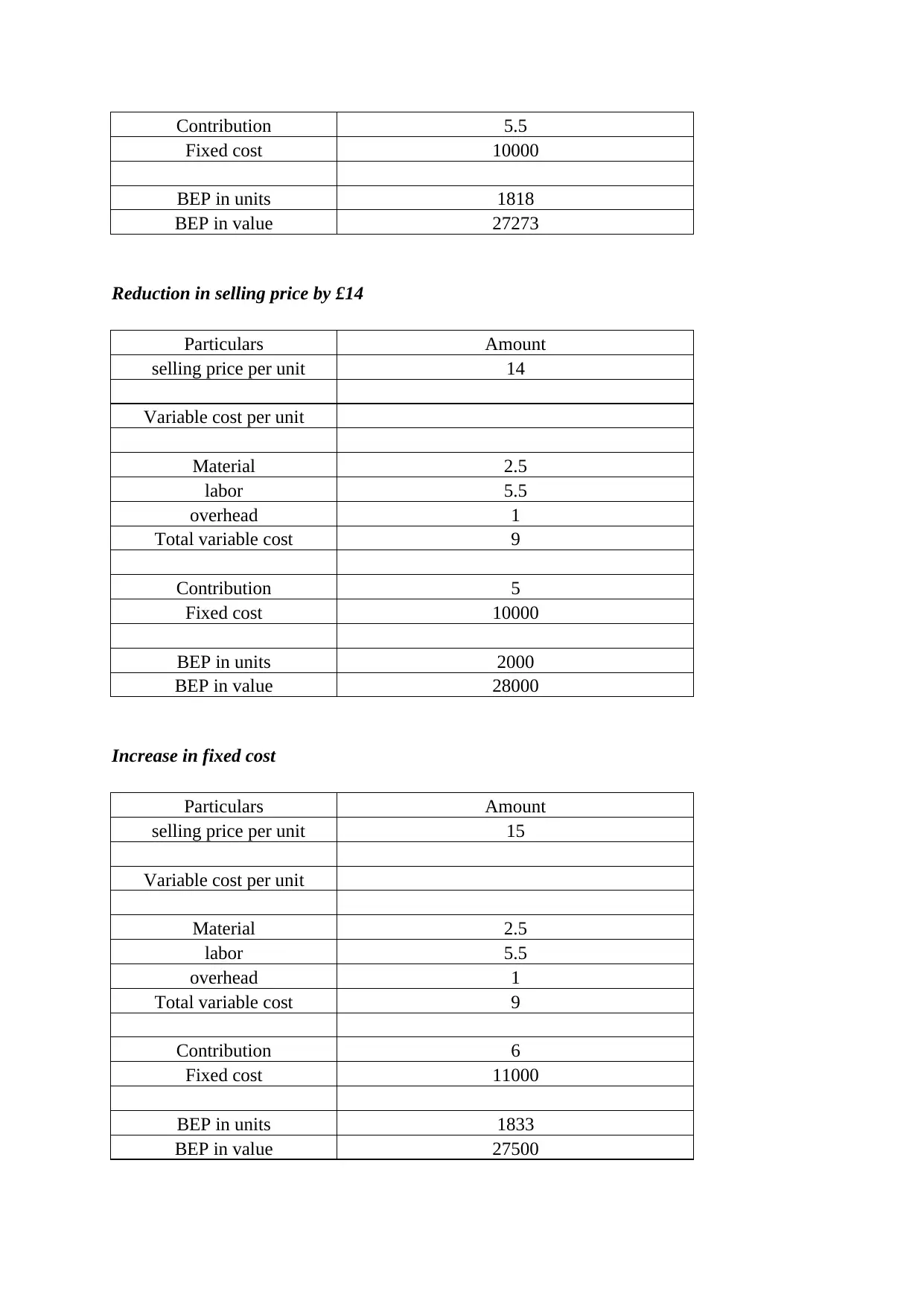
Contribution 5.5
Fixed cost 10000
BEP in units 1818
BEP in value 27273
Reduction in selling price by £14
Particulars Amount
selling price per unit 14
Variable cost per unit
Material 2.5
labor 5.5
overhead 1
Total variable cost 9
Contribution 5
Fixed cost 10000
BEP in units 2000
BEP in value 28000
Increase in fixed cost
Particulars Amount
selling price per unit 15
Variable cost per unit
Material 2.5
labor 5.5
overhead 1
Total variable cost 9
Contribution 6
Fixed cost 11000
BEP in units 1833
BEP in value 27500
Fixed cost 10000
BEP in units 1818
BEP in value 27273
Reduction in selling price by £14
Particulars Amount
selling price per unit 14
Variable cost per unit
Material 2.5
labor 5.5
overhead 1
Total variable cost 9
Contribution 5
Fixed cost 10000
BEP in units 2000
BEP in value 28000
Increase in fixed cost
Particulars Amount
selling price per unit 15
Variable cost per unit
Material 2.5
labor 5.5
overhead 1
Total variable cost 9
Contribution 6
Fixed cost 11000
BEP in units 1833
BEP in value 27500
⊘ This is a preview!⊘
Do you want full access?
Subscribe today to unlock all pages.

Trusted by 1+ million students worldwide
1 out of 16
Related Documents
Your All-in-One AI-Powered Toolkit for Academic Success.
+13062052269
info@desklib.com
Available 24*7 on WhatsApp / Email
![[object Object]](/_next/static/media/star-bottom.7253800d.svg)
Unlock your academic potential
Copyright © 2020–2025 A2Z Services. All Rights Reserved. Developed and managed by ZUCOL.





